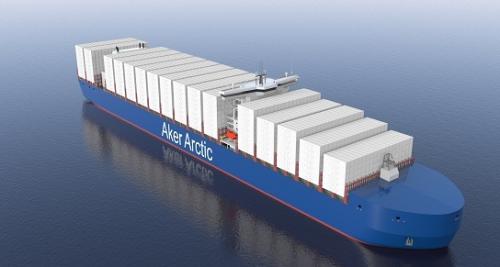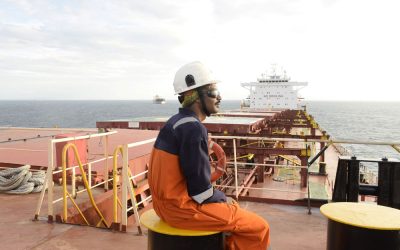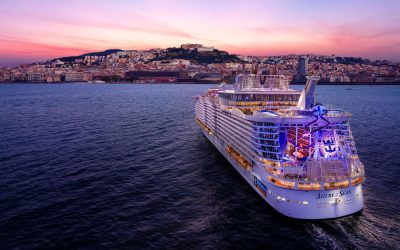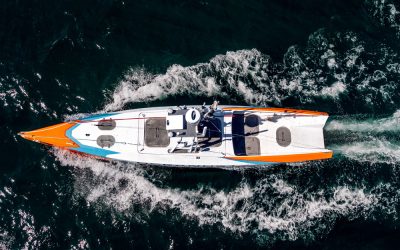Although the global warming that facilitated it is a clear cause for concern, the opening up of the Northern Sea Route (NSR), heralded when Sovcomflot’s LNG carrier Christophe de Margerie became the first vessel to navigate the waters without the support of a dedicated icebreaker in August 2017, was a watershed moment for commercial shipping.
Designed by Finnish naval architects Aker Arctic, the Arc7 LNG carriers are now a 15-strong fleet dedicated to transporting gas from the Yamal Peninsula. In October 2021, Aker Arctic and Korean shipyard DSME jointly announced plans for six second-generation Arc7 carriers, this time for Novatek’s Arctic LNG 2 project, which may be powerful enough to navigate the more challenging eastern sector of the NSR even during the winter months.
But might similar solutions be applied to other ship types and what would be the economic argument for utilising the NSR? Aker Arctic recently set itself the challenge of developing an icebreaking container ship which could use the NSR on a year-round basis. The result is the Arctic container ship, a design for an 8,000TEU vessel that could potentially expedite the transit of goods between Asia and Europe. In addition to features such as an ice-strengthened hull and icebreaking bow, the design incorporates a number of innovations, including Aker’s Double Acting Ship propulsion technology.
While the company had previously designed a 648TEU capacity general cargo ship some years ago, RekoAntti Suojanen, managing director for Aker Arctic Technology, tells TNA that it’s ostensibly a completely new concept, albeit one that draws heavily from the experiences of the Arc7 carriers. However, there are some key differences. He explains: “The technical and environmental challenges are the same but with transporting containers through the Arctic seas, principally without stopping at the local ports, the logistics are very different to exporting liquid cargoes.”
Shallow draft
Like the Arc7 carriers, the proposed container ship has a 300m LOA and, crucially, a shallow draft of 13m that factors in the limited depth on the Arctic routes. Luigi Portunato, who led the research, says that this has meant some adaptations compared to a standard vessel of equivalent size that might operate along a more conventional Asia-Europe route via the Suez, but in many respects the differences are negligible. “With the icebreaking hullform you get some displacement in the bow compared to those vessels, which affects the amount of containers you can bring in…. The [slightly wider] beam is optimised for the ice but that’s even better for the containers than an open water vessel.”
Despite that this also means increased resistance, Suojanen stresses that one of the ideas behind developing an NSR optimised ship is to arrive at a solution for the overall distance the ship would be travelling. “That was why we made certain changes for the second generation of LNG carriers, because the main transport route is different from the first generation. The first generation are sailing from Sabetta to European ports, but the next ones are from Sabetta to Asian ports. So the balance between the ice navigation and the open water seas is different.”
One advantage of having a slower open water speed is that the additional installed power required for icebreaking is only around 12%. Portunato estimates an average speed of 14-15knots should be possible across the entire voyage during winter conditions, with much faster speeds during the summer months. In that respect container ships have an advantage over the gas carriers, given that their schedules can be adjusted to account for any delays, whereas gas and oil production requires a constant routine.
Power and steering
Double acting ship technology, which allows a ship to turn around and proceed astern in heavy ice conditions, has been a common feature of icebreaking ships for many years. Aker’s own Double Acting Ship (DAS) solution dates back to the early 2000s and comprises a single shaftline with two azipod units on the sides.
Alternatively, shipowners interested in the Arctic container ship can choose a design with two conventional shaftlines and rudders, although such vessels require the assistance of an additional icebreaker during heavier ice conditions, given their lower icebreaking capabilities. Suojanen comments that despite the advantages of the DAS configuration, which allows for a larger propeller (and therefore wake field), with the azipods also helping to stabilise speed in open water, many shipowners still appear to be reluctant about what they perceive as a more complicated propulsion arrangement.
Typically, double acting ships have the deckhouse located at the stern of the ship, making it possible to navigate backwards. However, the Arctic container ship has its deckhouse located midship, so to negotiate this problem the design incorporates a special aft wheelhouse at the stern. Portunato says: “The idea is to have a second steering position with the same equipment as the main one, also with cameras and things like that, in the covered mooring deck under the containers.”
| TECHNICAL DETAILS | |
| Container capacity: | 8,000TEU |
| Length overall: | 300m |
| Breadth | 46m |
| Draught: | 13m |
| Installed propulsion power: | |
| A version: | 56MW (1 x 22MW shaftline, 2 x 17MW thrusters) |
| B version: | 44MW (2 x 22MW shaftlines) |
| Icebreaking capability: | Level ice performance ahead (3knots) |
| A version: | 2.3m |
| B version: | 1.9m |
| Ice class: | RMRS Arc7 |






